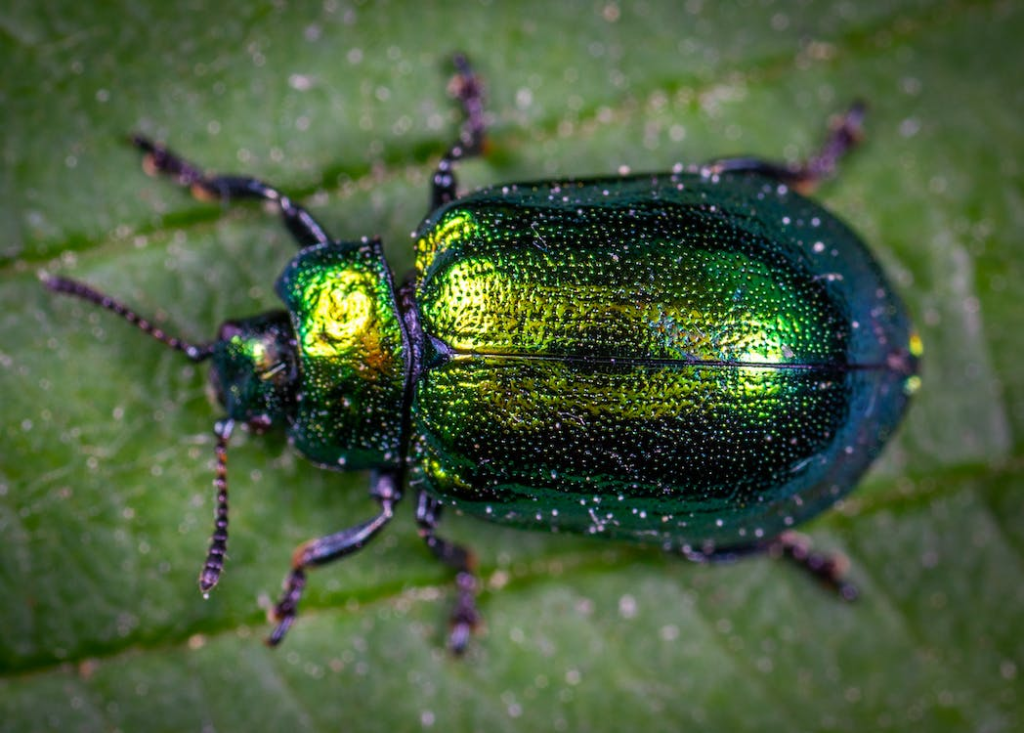With over 400,000 recognized species, beetles are among the most species-rich orders of insects. While the vast majority of these creatures pose little threat to human health or property, others can wreak havoc on gardens, farms, and houses. Fortunately, several approaches may be taken to reduce beetle numbers and protect against damage they may cause.
We’ll look at both natural and chemical insecticides as well as other techniques for controlling beetles in this article. Farmers, gardeners, and anybody else concerned about beetle infestations in their homes might benefit from these techniques.

Beetles: What Are They?
Beetles are a group of insects that belong to the order Coleoptera. Coleoptera is the largest order of insects, with about 40% of all insect species. Beetles have a hard shell made of chitin that helps them stay safe from predators and other dangers in the environment. They also have two sets of wings. The front wings, called elytra, are hardened and protect the back wings and body.
Beetles come in many different shapes, sizes, and colours, from the tiny featherwing beetles that are less than 1 mm long to the huge Goliath beetle that can grow up to 11 cm long. They live in almost every kind of environment on Earth, from humid rainforests to deserts.
Beetles are important parts of most ecosystems because they eat dead things, spread pollen, and feed other animals. But some kinds of beetles can do a lot of damage to crops, trees, and other plants. This makes them important pests in farming and forestry.
What Methods Are Used To Control The Beetle?
Several methods can be used to control beetle populations in Melbourne, depending on the species of beetle and the extent of the infestation. Some of the most effective methods are
Cultural Control
By making environmental changes that insects find unfavourable, beetle populations can be managed through cultural control. This strategy is widely employed in agricultural and gardening contexts, but it can also be useful in other places where beetle populations need to be managed.
Reducing or eliminating beetle habitats, food sources, and reproductive locations through cultural management. Insects like beetles rely on decomposing plant materials for both shelter and food, so getting rid of piles of dead leaves, grass clippings, and other organic matter can help. Beetles can be discouraged by maintaining a clean, clutter-free space surrounding your plants.
Planting a new crop each season in a field or garden is another cultural control approach that can be used to lower the population of pests like beetles by disrupting their life cycles. Soil-dwelling beetles, which feed on plant roots, are particularly amenable to this strategy for pest management.
Planting beetle-resistant plant species, utilizing natural fertilizers, and maintaining good soil can all contribute to a less welcoming environment for beetles in a garden. Cultural control can be employed by itself or in conjunction with other strategies to reduce beetle damage and protect plants while being cost-effective and environmentally benign.
Biological Control
Using predators, parasites, and diseases found in the wild to lower beetle populations is one example of biological control. To reduce the use of chemical pesticides, this technique is frequently employed in agricultural settings, forest management settings, and landscaping settings to manage beetle infestations.
Beetle populations can be reduced by biological control by introducing or strengthening natural enemies of beetles like predators and parasites. Several beetle species have natural predators, such as ladybugs, lacewings, and parasitic wasps; by introducing these creatures to an area, the beetle population can be reduced. These predators prey on beetle larvae, hence lowering the population of adult beetles that might cause harm to crops.
The use of microorganisms with illnesses or pathogens that only affect the beetle species counts as biological control, too, much like the use of predators. It is usual practice, for instance, to employ the bacterium Bacillus thuringiensis to kill beetle larvae to protect crops and gardens from damage.
Several elements influence how efficient biological control is. They include the type of beetle, the availability of natural enemies, and the surrounding environment. When attempting to reduce the number of beetles in an area, the introduced natural enemies must be those most suited to the area’s ecosystem and most capable of doing so without causing any harm to the beetles themselves or any other native species.
Chemical Control
Chemical control is a strategy for managing beetle populations that makes use of chemicals designed to either kill or deter insects. Beetle pests are notoriously difficult to handle, hence this technique is frequently employed in agricultural, forestry, and landscaping settings.
Chemical control employs the use of pesticides, which are sprayed on infested areas or consumed by pests, to eliminate or discourage beetle populations. Insecticides that kill or repel adult beetles are available, and systemic pesticides that are absorbed by plants to prevent beetle harm are among the other options.
If you decide to employ chemical control, make sure you read and follow all of the product’s directions and safety warnings. Wearing protective gear, utilizing the right tools, and delaying application during peak bee and pollination activity are all good places to start.
Pesticides used for beetle control must be carefully chosen because some of them can be detrimental to useful insects, birds, and other species. Because some beetle populations may develop resistance to particular pesticides over time, it’s also important to switch between different pesticides regularly.
Physical Control
Removal of beetle populations from an area or the use of physical barriers are examples of physical control. Controlling beetle pests without the use of chemicals is a common practice in gardening, landscaping, and agriculture.
Beetle populations can be reduced using physical control methods, however, doing so may be time-consuming and require regular monitoring. Also, if there are a lot of beetles already present, it might not be possible to use exclusion techniques.
Physical control, in combination with other approaches, can limit beetle damage and protect plants from the potentially devastating effects of these pests. To figure out what methods of physical management will work best for eradicating a particular species and level of beetle infestation, it is important to speak with a professional pest control agency.
It’s worth noting that the Japanese beetle and other invasive pest species of beetle in Melbourne may necessitate more stringent methods for their eradication. While trying to get rid of beetles, it’s advisable to talk to an exterminator about what measures will work best given the species and severity of the infestation.
Conclusion
Despite the difficulty, there are several efficient strategies for reducing the number of beetles in an area, hence reducing the amount of damage they do to plants and vegetation. Cultural control employs measures to prevent future infestations, whereas biological control makes use of natural enemies like predators or viruses.
Both chemical and physical methods can be used to manage beetles; the former makes use of pesticides to kill or deter the insects, while the latter entails physically eradicating or excluding the pests from a given region.
There are benefits and drawbacks to each technique; the most efficient strategy may vary with the type of beetle and the severity of the infestation. Yet, it is possible to minimize beetle damage and preserve plants in a sustainable and environmentally friendly way by employing a combination of these measures and following best practices for pest control.
To know more hop to weblink.
